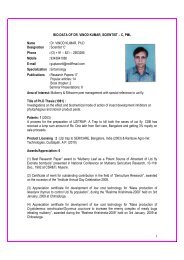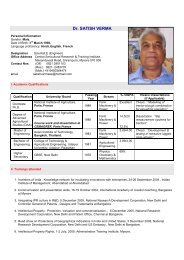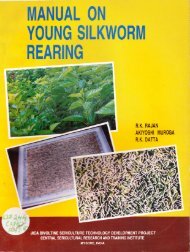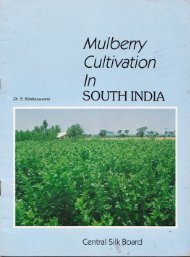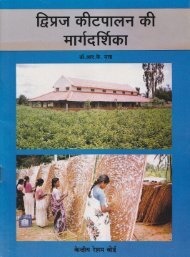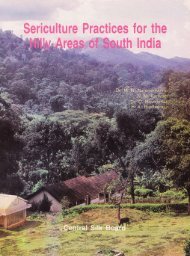BIVOLTINE RACE AND
Manual on Bivoltine Rearing, Race Maintenance and Multiplication
Manual on Bivoltine Rearing, Race Maintenance and Multiplication
- No tags were found...
Create successful ePaper yourself
Turn your PDF publications into a flip-book with our unique Google optimized e-Paper software.
-<br />
-<br />
-<br />
-<br />
-<br />
-<br />
-<br />
-<br />
-<br />
-<br />
-<br />
-<br />
-<br />
-<br />
Arrange the required number of mountages well in advance and also mount the worms<br />
when they are fully mature. Any negligence at this stage is bound to cost the rearer<br />
heavily.<br />
Mount spinning worms by hand picking or shoot shaking followed by self mounting. Each<br />
method has its own advantages and disadvantages.<br />
Pick the matured silkworms individually by hand inhand picking method. The advantage<br />
of this method is properly matured worms alone can be collected. This method is time<br />
consuming.<br />
In the case of shoot.shaking method, when 30Vo of the silkworms have become matured,<br />
the shoot to which they are attached is shaken by haird or vibrated mechanically to shake<br />
off the silkworms and to collect them on a cocooning frame.<br />
During self mounting, silkworm larvae attached to mulberry shoots are shaken before<br />
optimum mounting stage and the larvae are again reared on a bed. Then at the time of<br />
mounting, the cocoon frame is placed over the rearing bed so that the matured larvae<br />
can climb up. This method is advantageous because the labour requirement is not more<br />
on the day of mounting. However, the disadvantages are that after shoot shaking,<br />
mulberry harvest or feeding, space and labour are needed for preparing new rearing<br />
beds.<br />
Use only clean and disinfected mountages.<br />
Mount about 30 - 40larvae /sq.ft.<br />
Use bamboo or plastic bottle brush or plastic collapsible mountages for seed cocoorV<br />
reeling cocoon production. However, in order to decrease the defective cocoons, such<br />
as soiled cocoons, mountage pressed cocoons, double cocoons etc., to improve the<br />
cocoon quality and to facilitate the adoption of free mounting method for the purpose<br />
of saving labour and to increase the reelability of commercial cocoons use rotary card<br />
board mountage (Figs. 7-9).<br />
Cover the plastic mountages with nylon or cotton net soon after mounting (Basic stock<br />
multiplication centre and Silkworm Breeding Lab) to avoid mixing of larvae (Fig. 10).<br />
Place old newspapers under the mounting frame to absorb urination and excessive<br />
moisture in the mounting room.<br />
When 807o of the larvae have been completed web fcrmation (hybri d20-24 hr. and parent<br />
race24-48 hr), without shaking the plastic mountage, gently remove the base paper and<br />
place the mountage upside down. This improves the reelability of the cocoons.<br />
Remove diseased and dead worms while taking out the paper placed on the base.<br />
Record shrunken larvae (non-spinning) noticed on the mountages. (If non-spinning<br />
larvae are more, transfer them to new mountages).<br />
Mounting of premature and over mature larvae affects the quantitative traits of the<br />
cocoon. The effect of early and late mounting on cocoon characters is given in Thble 7.<br />
19




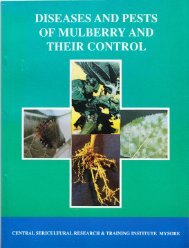

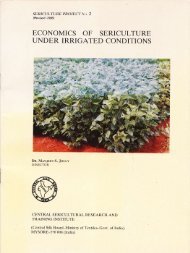
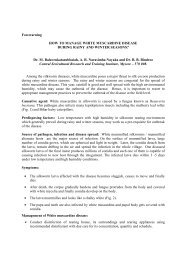
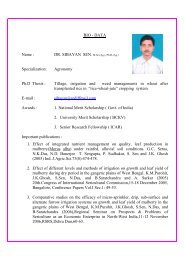
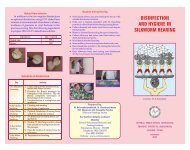
![E}A]\GALORE](https://img.yumpu.com/54052619/1/190x260/eagalore.jpg?quality=85)

